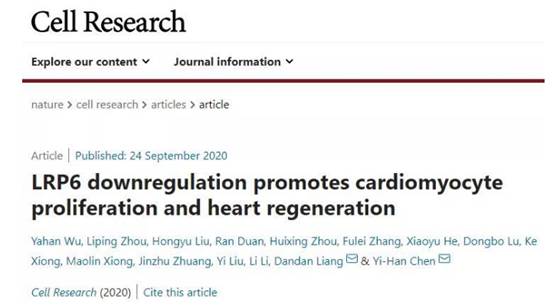The adult mammalian heart is thought to be a terminally differentiated organ given the postmitotic nature of cardiomyocytes. Consequently, the potential for cardiac repair through cardiomyocyte proliferation is extremely limited. On September 24, a research paper with CHEN Yihan, Academician, Vice President of Tongji University and LIANG Dandan, associate researcher as the co-corresponding authors, was published online in "Cell Research". The paper was titled "LRP6 downregulation promotes cardiomyocyte proliferation and heart regeneration". In this study they investigated the role of LRP6 in heart repair through regulation of cardiomyocyte proliferation.
Lrp6 deficiency increased cardiomyocyte cell cycle activity in neonatal, juvenile and adult mice. Cardiomyocyte-specific deletion of Lrp6 in the mouse heart induced a robust regenerative response after myocardial infarction (MI), led to reduced MI area and improvement in left ventricular systolic function. In vivo genetic lineage tracing revealed that the newly formed cardiomyocytes in Lrp6-deficient mouse hearts after MI were mainly derived from resident cardiomyocytes. Furthermore, they found that the pro-proliferative effect of Lrp6 deficiency was mediated by the ING5/P21 signaling pathway. Gene therapy using the adeno-associated virus (AAV) 9 miRNAi-Lrp6 construct promoted the repair of heart injury in mice. Lrp6 deficiency also induced the proliferation of human induced pluripotent stem cell-derived cardiomyocytes (iPSC-CMs). Our study identifies LRP6 as a critical regulator of cardiomyocyte proliferation, which may lead to the development of a novel molecular strategy to promote myocardial regeneration and repair.

Numerous heart diseases are associated with loss or dysfunction of cardiac muscle cells. However, adult cardiomyocytes largely lose their ability to undergo cell division and proliferation after a narrow proliferative window at the neonatal stages. As a representative organ with poor regeneration capacity, the adult heart is particularly vulnerable to failure following injury responses. Adult mammalian hearts form fibrotic scars in response to injury, which can lead to heart failure, arrhythmia and death. Current treatments can temporarily improve heart function but do not replace lost cardiomyocytes. Mammalian tissues exhibit specific rates and mechanisms of cell turnover, and different organs vary widely in repair capacity. Lineage mapping analyses in neonatal mice and adult zebrafish have suggested that the majority of regenerated cardiomyocytes are derived from pre-existing cardiomyocytes. In addition, many studies have proposed that the adult mammalian heart is capable of turning over cardiomyocytes following injury, suggesting that cardiomyocyte proliferation could be an effective strategy for heart repair. Thus, understanding the mechanisms under-lying the proliferative capacity of cardiomyocytes and how to control the process of cardiomyocyte proliferation is key for the successful repair of heart injuries. Low-density lipoprotein receptor-related protein 6 (LRP6), a single-span transmembrane protein that plays a key role in the transduction of the canonical Wnt/β-catenin signaling pathway has been demonstrated to be essential for cardiac neural crest and outflow tract development. Ablation of Lrp6 in mice affected the proliferation and survival of cardiac progenitors and caused a range of severe morphogenetic defects during early cardiogenesis. In adulthood, LRP6 dysfunction has been linked to coronary artery disease and fatal cardiac arrhythmia. However, little is known about the potential role of LRP6 in cardiomyocyte cell cycle activity. In the present study, they found that Lrp6 deficiency increased cardiomyocyte proliferation at different stages in mouse heart and human induced pluripotent stem cell-derived cardiomyocytes (iPSC-CMs). Lrp6 deficiency in the mouse heart reduced the size of the myocardial infarction (MI) and improved heart function. The ING5/P21 signaling pathway was shown to be responsible for the effects of LRP6 on cardiomyocyte proliferation. After injury, administration of an AAV9 construct encoding miRNAi-Lrp6 promoted heart repair in the mice. Thus, this study reveals a novel molecular switch controlling the re-entry of cardiomyocyte cell cycle and a promising intervention target for cardiac regeneration.
